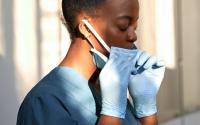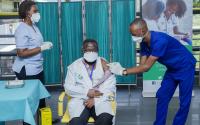[ad_1]
Race and low socioeconomic status once again factor high on the list of vulnerabilities to COVID-19 infection and death in two US studies published late last week, one finding county-level inequalities and one linking ethnicity and community exposure to infections among healthcare workers (HCWs).
Table of Contents
‘Pockets of disadvantage everywhere’
In the first study, published in JAMA Network Open, University of Michigan at Ann Arbor researchers used the Social Vulnerability Index (SVI) to analyze the sociodemographic factors of 4,289,283 coronavirus-related infections and 147,074 deaths in 3,137 US counties from late March to Jul 29, 2020.
The 10-point SVI, created by the Centers for Disease Control and Prevention (CDC), is based on US Census data on socioeconomic status, household composition (eg, number of people, single-parent status), housing, age, disability, racial/ethnic makeup, and English language proficiency. Scores range from 0 to 1, with higher scores indicating greater disadvantage.
The researchers found that COVID-19 cases increased faster in counties with higher SVI scores during the study period and that those with higher rates of factors not measured by the SVI, such as reliance on public transportation, food insecurity, lack of health insurance, and obesity, also had higher proportions of coronavirus infection and death.
A 0.1 increase in SVI score was linked to a 14.3% rise in COVID-19 incidence and a 13.7% increase in deaths (incidence rate ratio [IRR], 1.14 for both). The percentages translate to 87 excess coronavirus infections and 3 related deaths per 100,000 and an SVI score change from 0.5 to 0.6 in a medium-sized metropolitan county. An increase of 0.1 point in overall SVI was tied to an increase of 0.9% each week in infection rate and a 0.5% rise in the death rate (IRR, 1.01 for both).
Counties with the highest percentages of racial minorities and people whose first language was not English had the highest rates of COVID-19 cases and deaths, and the counties measuring highest on these factors had a 22% hike in cases and a 17% rise in deaths for every increase in SVI score.
The findings should be a source of concern for the entire country, study coauthor Monita Karmakar, PhD, said in a University of Michigan press release. “Our findings highlight that there are pockets of disadvantage everywhere in America, and that they are playing a large role in the pandemic that’s affecting all of us as we interact with one another,” she said.
Coauthor Renuka Tipirneni, MD, said in the release that social disadvantage is the underpinning of high COVID-19 burdens. “While the first surge was mainly in urban areas with high percentages of Black and Latinx residents, as time went on some of [the] highest rates of cases and deaths were in rural counties with predominantly white populations,” she said. “But across the board, we find the areas hardest-hit by the disease were linked by higher rates of social disadvantage.”
To address these social determinants of health, the research team recommends public outreach campaigns targeting people with lower English proficiency; expansion of COVID-19 testing, treatment, and vaccination in the most affected counties; and government/nonprofit coordination of housing and food assistance.
“Investments in public policies that protect everyone, like paid sick leave, affordable housing, high-quality education and health insurance are needed to reduce the social inequalities that drive every type of health inequality, including COVID-19,” coauthor Paula Lantz, PhD, said in the release.
Black race, community exposure in infected HCWs
In the second study, published in the Annals of Internal Medicine, a team led by researchers at Emory University used coronavirus antibody test data and surveyed HCWs in the Emory Heathcare system about use of personal protective equipment at work and possible exposure to the virus at work and in the community from Apr 19 to Jun 26, 2020.
Among the 10,275 participating HCWs (35% of the system’s workforce), after adjustment for imperfect test sensitivity and specificity, 3.8% tested positive for coronavirus antibodies on serologic testing, indicating exposure to COVID-19 at some point.
Both community contact with someone known or thought to have COVID-19 was a risk factor for infection (10.3% of all infections; adjusted odds ratio [aOR], 1.9), and community case incidence (aOR, 1.5) increased the risk. Nearly half (44%) of the 555 seropositive HCWs reported no characteristic COVID-19 symptoms over the study period.
Black HCWs were at twice the risk of their white peers (8.3% of all infections; aOR, 2.1), although they were not well represented in the study, making up 30% of those tested but 49% of the workforce. Multiracial HCWs were at 1.7 times the risk of their white counterparts.
While the odds of positivity for COVID-19 antibodies did not increase for HCWs with direct patient contact (aOR, 0.9), those who worked in clinical settings such as noncoronavirus-dedicated hospital areas, the emergency department, and areas dedicated to COVID-19 care were at higher risk of infection (aOR, 1.4, 1.5, and 1.6, respectively).
Respiratory therapists and those working in the operation room or procedure areas, who would be expected to be exposed to patient-generated respiratory aerosols, were not at elevated risk for COVID-19 antibodies (aOR, 0.9 and 1.1, respectively). However, the researchers noted that surges of coronavirus patients caused major shifts in care delivery and HCW deployment that could have compromised the study results.
The authors concluded that risk factors related to demographics and community risk, including exposure to someone with COVID-19 and black race, were more strongly linked to infection among HCWs than workplace exposure.
Even after partially adjusting for community risk through ZIP code–level coronavirus incidence, the researchers said they couldn’t account for other contributing factors for high risk among black HCWs, such as higher likelihood of household exposure or reliance on public transportation. “Ultimately, these structural risk factors are tied to entrenched, systemic social processes that underlie many individual and population health disparities,” they wrote.
The researchers emphasized the importance of ongoing efforts to help ensure HCW safety through risk mitigation both on the job and in the community and added, “Future seroprevalence studies of HCWs need to account for these community and demographic factors.”
[ad_2]
Source link












